JUNE 2019 ENEWS
.jpg)
Dear friends of Salt Point and Fort Ross,
Fort Ross Festival is upon us! Part California-style historic re-enactment, part community festival, this event has been growing strong for decades and it is the high point of our year. Our marvelous volunteer coordinator Melissa Bushner has gathered a talented group of craftspeople, performers, and volunteers to fill the fort compound with activities for all ages. We’ve got new Americana music - Dirty Cello - in the Call Picnic Beer Garden, and several fantastic groups performing in the compound. And yes, we will fire the cannon! Details on our website - please help us spread the word. Hope to see you on July 27th
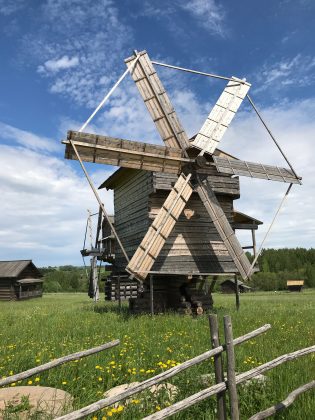
Earlier this month a few of us from FRC (Director Deborah Gordon, FRC’s Hank Birnbaum, and myself) made the trek to Vologda, Russia, whence Fort Ross founder Ivan Kuskov hailed, to attend Fort Ross Dialogue-Russia, a conference exploring cultural and scientific connections between the US and Russia. Our hosts were gracious, the conference informative, and the visit to rural northern Russia truly inspiring. The people of Vologda and Fort Ross have stayed in touch through the years by participating in several video “bell bridges” during our festivals, and we opened the conference with this sweet video welcome created by our ELP students. People to people connections make all the difference! These photos are from the village of Semyonkovo and the Museum of Ethnography and Wooden Architecture, where a number of the house interiors have been preserved or re-created in the traditional manner. Sure does look like Fort Ross! Hank Birnbaum will be posting about the trip and the historical connections over the coming weeks on our Facebook and Instagram accounts.
Fort Ross history is rich with stories, some more accessible than others. One such buried story is the shipwreck of the SS Pomona. On March 17, 1908, while on its usual run between San Francisco and Fort Ross, the Pomona struck rocks just south of Fort Ross and ran aground on the north end of Fort Ross Cove, where its remnants remain to this day. FRC staff was fortunate to meet John Harreld (Sonoma County diver, California State Parks Diver and Archaeology volunteer, scientific diver volunteer for UC Davis Bodega Marine Lab, and co-founder of Sonoma Coast Historic and Undersea Nautical Research Society (SCHUNRS)), who shared footage of his June 2019 dive of the Pomona. To see photos of the ship in her glory visit our website, and stop by the museum to see a few artifacts.
There are more stories to tell, but I must let my team have their say. And if you like what you read, please considering supporting Fort Ross Conservancy by making a donation today. We rely on your support.
I hope to see you at Fort Ross and Salt Point soon.
Sarah
sarahs@fortross.org
Park Champions at Salt Point
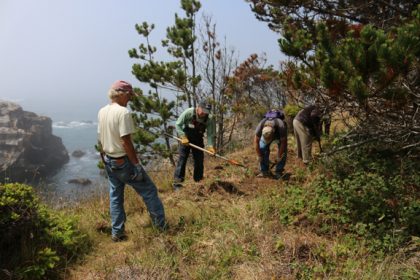 Join us on June 23rd for a Park Champions work day in the Kruse Rhododendron State Reserve! Volunteers will help park staff with trail brushing and trimming. Free camping at Woodside Campground included for Saturday and Sunday nights. Check out the Park Champions website for more information and scroll down to the calendar to sign up by clicking on Salt Point on June 23rd.
Join us on June 23rd for a Park Champions work day in the Kruse Rhododendron State Reserve! Volunteers will help park staff with trail brushing and trimming. Free camping at Woodside Campground included for Saturday and Sunday nights. Check out the Park Champions website for more information and scroll down to the calendar to sign up by clicking on Salt Point on June 23rd.
http://calparks.org/help/park–
FORT ROSS FESTIVAL

Looking for the perfect way to celebrate Summer in Sonoma County? Join us on July 27th for Fort Ross Festival! Where else can you witness Kashia Pomo ceremonial dancing, listen to folk, gypsy, and bluegrass music, learn from Alaska Native craftspeople, and take in traditional Russian performances, all together on the most beautiful stretch of the Sonoma coast? Grab a pint from our Beer Garden and enjoy an amazing day celebrating different cultures. Back by popular demand, join the Fort Ross Militia for Musket and Cannon Firings, and have a BLAST at Fort Ross!
Tickets are on sale at Eventbrite!
Indians of California - Catalog of the Kunstkamera Collection

Many Americans and Russians are surprised to learn that the world’s largest and most unique collection of California native artifacts resides in a museum in St. Petersburg, Russia. These items were given to the museum by the Russian American Company (RAC), whose 19th century scientists explored the world’s oceans on missions of discovery and trade. RAC expeditions reached the shores of California where they founded Fort Ross and soon began collecting natural and cultural objects to advance science in their home country. Importantly, these artifacts were obtained from tribes in the years before the Gold Rush, a transformative time in California history that nearly destroyed our local native cultures. The existence of this collection is remarkable, and keenly important to Native American tribal members, archaeologists, and ethnographers.
The Kunstkamera graciously donated two copies of their new 344-page color-photo Russian-language “California Collection” Catalog to the Kashaya Tribe and Fort RossLibrary. A precious window into yesteryear, hopefully to be treasured by many.
Our FRC copy is kept in the Fort Ross Library reference section, for onsite access only. A second copy is in the Kashia Band of Pomo Indians administrative office library, in Santa Rosa.
This project was partially funded through a Fort Ross Conservancy grant to the US Embassy. FRC is currently working with the museum to locate funding needed to publish an English language version of the catalog, with an anticipated release in 2020.
This large-format, hardbound, richly illustrated Russian-language catalog is the fourth in a series of published Kunstkamera scientific catalogs dedicated to the museum’s Northern American collections. Previous publications: “Tlingit” (2007), “Eskimo Alutiiq” (2010), “Aleut” (2014).
A few delegations of Kashia Pomo, Coast Miwok and others have visited the Kunstkamera through the years, have met with Kunstkamera staff, and have been offered special access to this collection. During these visits, tribal members and specialists have shared information with the Kunstkamera staff concerning their collection, including which materials or plants were likely used to make them, the purposes of the items, and sometimes their likely place or tribe of origin.

The Kunstkamera is also known as the Peter the Great Museum of Anthropology and Ethnography of the Russian Academy of Sciences (Russian: Музей антропологии и этнографии имени Петра Великого Российской академии наук). Established by Peter the Great in 1714, the Kunstkamera is Russia’s first museum and hosts a collection of almost 2,000,000 items. The Kunstkamera is located on Saint Petersburg’s Universitetskaya Embankment across the Neva River from the Winter Palace and the Hermitage.
Saint Petersburg is known as Russia’s “Window to the West,” and this publication offers a unique look into the most complete collection of 19th century Native Northern and Central Californian artifacts and enduring culture.
--Hank Birnbaum, Bilingual Guide, Historical Specialist & ELP Instructor
Searching for Balance in an Underwater World Gone Upside Down
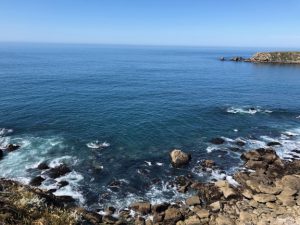
For many locals in our Northern California community, reading that we are in the midst of a devastating imbalance within our Pacific coastal intertidal zones will not come as a surprise. This is due to a chain of events spanning almost 200 years. This story is one of ripples, spreading ever outward: one imbalance leads to another, and another.
To learn the history of Fort Ross is to know the plight of the sea otter and to understand how the effects of our human practices can have long term, sometimes catastrophic results. The Sonoma Coast has had a regional extinction or extirpation of sea otters for the last 100+ years, since the Russian, American, and British over hunted the animals. These furs were so valuable that a hunter could earn a year’s salary with just one pelt.
The sea otter is an apex predator. It consumes 20 to 30 percent of its body weight daily, helping to keep other species under control. The sea otter has been gone from Sonoma Coast for over 100 years, but it was a series of subsequent events that caused our ecosystem to crash.
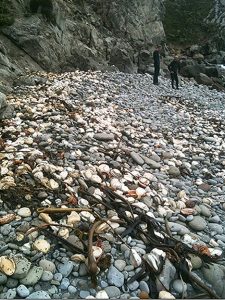
It started with a severe algal bloom, or red tide, in 2011, during which Fort Ross’s abalone population was hit particularly hard. Then in the summer of 2013, our coast was hit by one of the largest die-offs of sea stars that scientists had ever seen. For the next two years, 2014 and 2015, our coasts continuously saw the warmest water on record due to the “Warm Blob” and a strong El Niño. These warm waters led to a massive bloom in purple sea urchin.
All these events, individually, may not have had a great impact, but together, they’ve created what CDFW calls the Perfect Storm. Even today, our waters continue to stay far warmer than in previous years, leaving room for the wasting disease and urchin populations to thrive. These are very clear signs of our rapidly changing climate.
One of the main species hit by the sea star wasting syndrome was the Sunflower Star (Pycnopodia helianthoides) and it was this species, along with the Ochre Sea Star (Pisaster ochraceus), that had been keeping the population of the Purple Sea Urchin (Strongylocentrotus purpuratus) in balance.
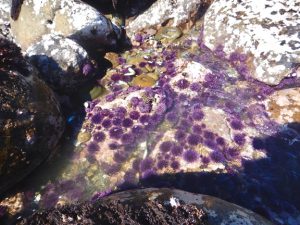
With few remaining natural predators, the now massive urchin population has transformed the sea floor into what are called urchin barrens. These fields of urchins have decimated their favorite meal, Bull kelp (Nereocystis luetkeana).
Bull kelp is a beautiful species of seaweed that grows seasonally, at times in Spring, up to ten inches a day. Its canopy is focused at the ocean's surface, as each stipe (stalk) ends in a gas filled bulb. Each bulb has many leaflike blades, sometimes over three meters long! It provides a sanctuary for fish and a food source to hundreds of species.
Since 2013, the Mendocino and Sonoma coasts have seen a 93% decrease in our Bull kelp forests. According to the Noyo Center’s Bull Kelp Recovery Program, “Fewer fish has meant that shore birds do not have enough food for their chicks. This year, 90% of the local cormorant and 80% of the black oystercatcher nestlings failed to survive. Fewer young fish also means fewer larger fish for marine mammals, such as harbor seals and sea lions.”
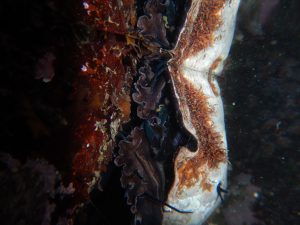
The next species hit by this story of ripples is the Red abalone (Haliotis rufescens). They have now lost their primary food source, the Bull kelp. Over the last four years, we have seen thousands of Red abalone wash up in Sandy Cove. Searching for a new food supply, they travel higher and higher in the intertidal zone, but they are not finding enough to remain strong and healthy and, as a result, are dying en masse.
The Red abalone population is dying in such high numbers that the CDFW has closed the entire California abalone season until March of 2021. This puts a strain on the commercial industry. There are many whose livelihoods depend on the income brought in from harvesting abalone, but this minor pause on the ‘take’ of abalone is essential to the preservation of the species.
The number one question I am asked as an educator is: why don’t we reintroduce sea otters? After speaking with Environmental Scientist Dr. Cynthia Catton of CDFW, I have a much better understanding of why this is not a simple fix to this complicated, multifaceted problem. To start, we seem to be too far into this imbalance to ‘throw’ sea otters into the mix. While sea urchin can be a favored food of some sea otters, at this point, even the urchins here are starving, so the nutritional value they would offer is minimal. Otters would only take the urchins still able to find food, on the edges, leaving all the barrens.
Additionally, otters learn what to eat from their mothers. If an otter’s mother does not eat urchin, then that otter also does not eat urchin, so reintroducing otters who might not even eat urchin would only put other species like the starving abalone at risk.
While it does seem bleak, there are things that we can do. It turns out, we may be the predators needed in this complicated tragedy.
Current research aims to create a new commercial purple urchin market by making agricultural compost out of their harvested tests (their hard outer body). For individuals, the daily bag limit used to be 35 urchins/person. Now the take is forty gallons a day, which is eight, five-gallon buckets. Their outer body is nearly pure calcium, adding excellent nutrients for soils. Collecting urchin, individually, or in groups, could help put a dent in the urchin overpopulation.
Most importantly, one of the biggest things you can do is help to spread the word. Be an educator! Both the Greater Farallones Association and the Noyo Center have excellent Kelp Recovery/Restoration programs and Fort Ross Conservancy continues to educate people about this issue. Together, we can make a difference.
“When we try to pick out anything by itself, we find it hitched to everything else in the Universe.”
-- John Muir
To learn the full story, read California Dept. of Fish and Wildlife’s “The Perfect Storm” article.
--Song K Hunter, Director of Programs
What Lies Beneath: The American Badger
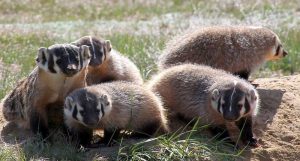
Between the diversity of weather and wildlife, the natural abundance offered by Fort Ross and Salt Point State Parks each spring is not to be missed. If you were among the visitors to get grounded in all the outdoor splendor, you may have noticed mysterious large holes springing up along our coastal blufftops. We noticed these holes along the coastal prairie during our monthly Sea Lion and Beach Watch surveys, and that provided the inspiration for this month’s creature feature.
Did you know that we share our beloved parks with American badgers (Taxidea taxus)? These striking animals with their distinct black and white facial markings are mostly active at night. If you see one during the day, it is probably a female who is spending her nights with her babies. In all the times I’ve hiked around our Parks, I’ve never seen a badger, but their presence is evidenced by their large den entrances. Badgers are built for serious digging. Their strong forelimbs with curved claws--up to two inches long--are not to be messed with! Their hind feet are shaped like shovels. These physical characteristics allow these two and a half foot, 20 pound furry mammals to dig out big burrows which serve many purposes: safety, sleeping, storing food, a birthing place, and a place from which to forage. Badger burrows can be ten feet deep and eight to ten feet across--not too shabby for Sonoma County beachfront property!
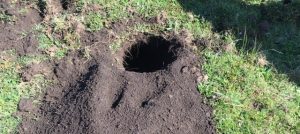
American badgers play an important role in our local food web. The ferocious claws for which badgers are known help them dig out prey animals such as mice, voles, rabbits and gophers. If the badgers are eating well, that means they’re helping to keep rodent populations at healthy levels. Thanks to those fearsome claws and carnivorous teeth, badgers don’t have many predators. They can be taken by eagles, coyotes, bobcats, and cougars. Fun fact: Badgers have lived in Sonoma County and surrounding areas since the Pleistocene Epoch! It is thought that their digging helped create cooling mud baths (or wallows) for prehistoric bison and mammoths.
The American badger belongs to the family Mustelidae (the Weasel Family), which makes them relatives of a famous, former resident at Fort Ross: the sea otter. The American badger has a considerable distribution range from Southern Canada, across the U.S. and into Northern Mexico. In California, they are wide-ranging but possibly rare and/or locally extinct where they lived historically. The California Department of Fish and Wildlife (CDFW) has classified the American badger as a Species of Special Concern in California. CDFW wants to better understand badger populations. To aid in this effort, you can report your badger and den observations on their website. The reporting form is simple and lets you easily upload photos.
Next time you are walking the blufftops at Fort Ross and Salt Point State Parks and encounter a good-sized hole in the ground you will know precisely what lies beneath: the exquisite excavator known as the American Badger. Keep in mind those formidable claws and mind the gap! If you are willing, snap a photo from a safe distance and report your observations to CDFW to help us learn how this species is faring, and to aid in the protection of this long-standing California native dweller. See you on the bluffs!
Have you seen an American badger in the wild? Tell us about it at info@fortross.org.
Animals of Sonoma County's Coastal Prairies
American Badger Info from California Nature Mapping
CDFW Badger Profile & Reporting
Click here to see an American Badger skull!
--Charon Vilnai, Programs Instructor, Sea Lion Survey Project Lead, & Call House Museum Lead
Field Trip Opportunities for ALL AGES on the California Coast!
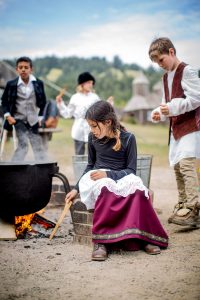 Extra extra read all about it! Fort Ross Conservancy is thrilled to provide so many opportunities for fun, outdoor education for all ages at Fort Ross. Help us spread the word and sign for your Marine Ecology Program, Educational Opportunity, or Environmental Living Program up today!
Extra extra read all about it! Fort Ross Conservancy is thrilled to provide so many opportunities for fun, outdoor education for all ages at Fort Ross. Help us spread the word and sign for your Marine Ecology Program, Educational Opportunity, or Environmental Living Program up today!
Fee Waivers Available! Public lands and outdoor learning experiences should be available to all, irrespective of the cost, and FRC aims to minimize the financial challenges that keep kids from taking important field trips. Thanks to the generous support from our donors we have created the Fort Ross Education Fund to offer program fee waivers and/or transportation subsidies to schools that would otherwise be unable to participate. We welcome teachers of all schools to apply!
For more information download the flyer.
Fort Ross Photo Contest
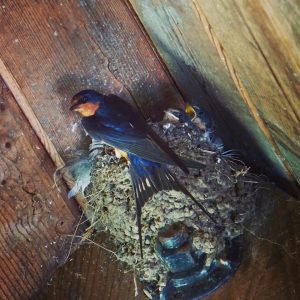
Calling all amateur photographers!
Fort Ross Conservancy is holding a photo contest leading up to our July 27th, 2019 Fort Ross Festival.
We will award three winners. Each winner will receive free entrance to Fort Ross Festival and -- if the winner is over 21 -- two free beers from our Beer Garden! We will print and display the three winning photographs during Fort Ross Festival for all to enjoy and appreciate.